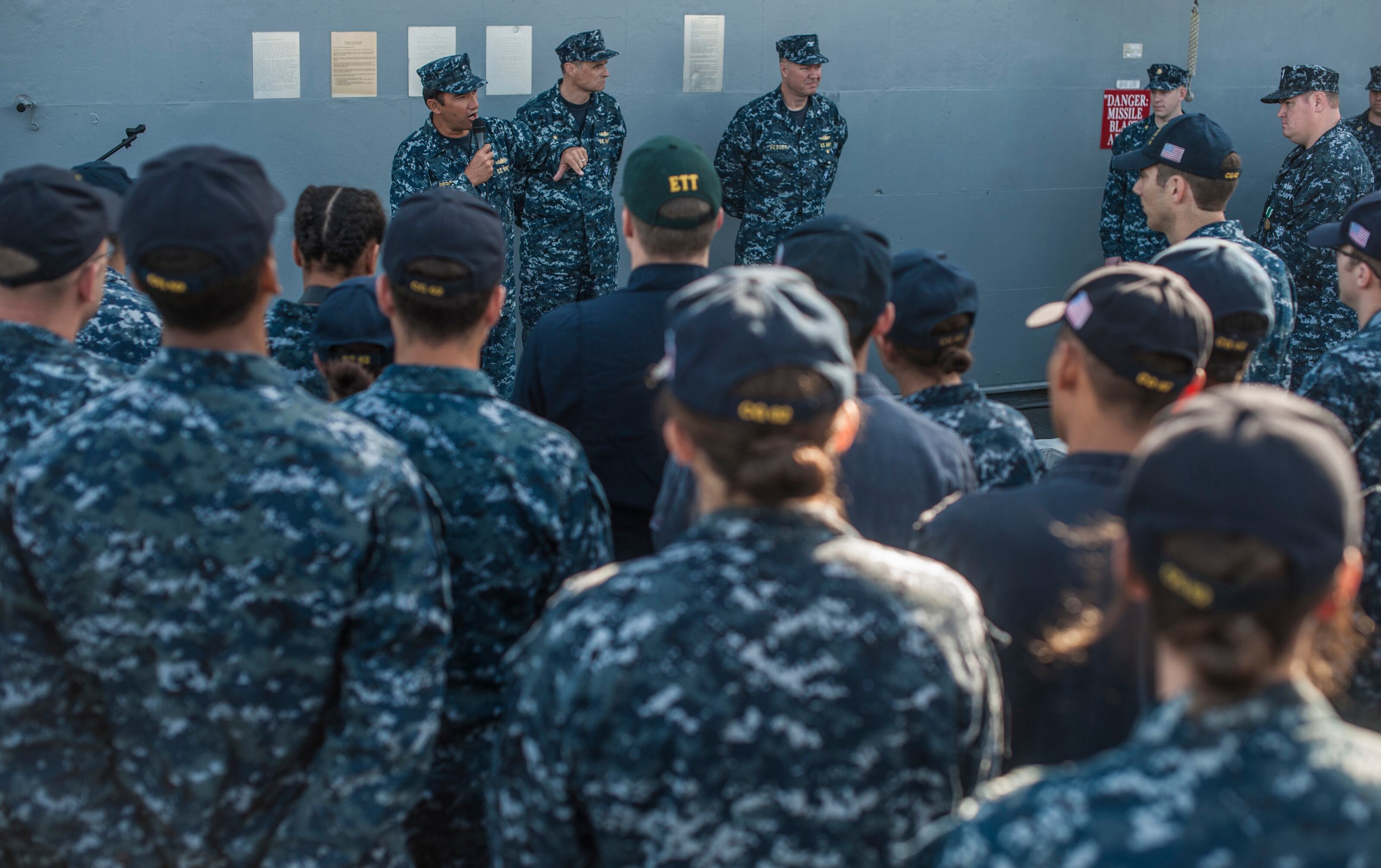Fire Controlman Second Class (SW) David Gentry was sending an email to a tech-rep in the cruiser Chancellorsville's main computer room 18 months ago when he saw a flash and heard an enormous bang.
"There was a flash and within an instantincident and without warning, the whole space was on fire," Gentry said, in an April interview with Navy Times. "It was just shock and adrenaline."
The Chancellorsville had been struck by a rogue drone during a training exercise off of Point Magu, California. The live, subsonic practice target — shaped like a missile and designed to test the ship's combat systems — punched through the port side of the ship and slammed into computer central, spraying jet fuel everywhere, before coming to a stop on the starboard bulkhead.
As Gentry headed to the exit, the drone's spilt spiled rocket fuel ignited, setting the space ablaze alightand inflicting second-degree burns on Gentry's hand and arm. But dDespite his injuries, Gentry rounded up the contractors in the ship's computer central and was the last to leave fiery spaceblazing space.
But not only did he ensure After ensuring the five contractors were safe, he also began fighting the fire by spraying CO2² bottles on the it., andwWhen he couldn't find any more CO2, he began to takefake out a hose and assemble a team to battle the blazeget a team together.
For his courage, Gentry, along with Chief Damage Controlman Jeremy Tuculet, was awarded the highest non-combat valor award, the Navy and Marine Corps Medal, at a March 19 ceremony on the Chancellorsville on March 19.

Piercey speaks to the Chancellorsville crew during a ceremony in which sailors were presented awards for heroism and bravery as a result of their actions as damage control first responders while combating a major fire.
Photo Credit: MC1 Trevor Welsh/Navy
In addition to Tuculet and Gentry, Lt. j.g. Clifford Ward and Hull Maintenance Technician 1st Class Christopher Kesser both received Navy and Marine Corps Commendation Medals for their actions, and Lt. Cmdr. James Santymire received the Meritorious Service Medal.
On Nov. 16, 2013, the cruiser ship was at the range to test its brand new, top-of-the-line AEGIS software and combat system. But it wasn't the combat system that was put to the greatest test that day, it was the skill and courage of the crew that found itself battling a major fire in one of the ship's most vital spaces.
At the ceremony, the ship's former commanding officer, Capt. Andrew Hesser, expressed his gratitude to the thanked the crew for acting quickly and saving lives.
"Thanks for everything you did that day, for your heroism, for saving the ship, for saving my life and the lives of the crew," Hesser said, according to a Navy release. "We were in trouble, and had you not taken the actions you did and put your training to use, we would have been inif far greater trouble. What these individuals did was truly heroic. I'll never forget it, and I can never thank you enough."
"We shooting the five inch?"
The Chancellorsville drone strike was one of the biggest mishaps of 2013. It decimated the ship's computer central and caused more than $30 million in damages to the space, which that had just been fitted with brand new blade servers.
The incident was the most serious involving a targeting drone since one a target drone struck the frigate Antrim in 1983, killing a civilian. The 13-foot BQM-74 series drone had a wingspan of 6 feet.
When Tuculet, the ship's top enlisted damage controlman, heard the drone strike, his first thought was that it was the ship's massive forward gun discharging a round.
"We actually had the [damage control training team] assembled in the ship's classroom, getting prepared for the evening's general quarters drill," Tuculet said. "I looked at the [executive officer] and said, 'Sir, we shooting the five-inch?' And he said, 'No, we shouldn't be.' Then a few deep breaths later we got the word of white smoke in the computer central p-way."
According to crew members, the fire produced a heavy, thick white smoke that quickly spread through the cruiser's forward aluminum superstructure.
Tuculet and HT1 Kesser entered the space, with Tuculet manning an infrared fire-finder., Kesser began hitting a small fire to their right with a CO²2 bottle. But then they found the big one: an electrical fire that was beginning to burn combustibles in the space, compounding the blaze.
They were pushed back out of the space and found a hose team ready to attack the blaze. At that point, Hesser got on the ship's main announcing system and ordered the hose team to spray down the fire.
According to the investigation, the water began to control the flames but also sparked new fires because the power hadn't yet been secured yet. In an effort to contain the new fires, the electricians began securing breakers to isolate the space.
Outside the skin of the ship, a second hose team was arriving to spray the flames through the hole made by the drone strike. A third team was also getting on station, which included Gentry, still who was suffering from his burns.
The word began spreading that Gentry was still in the space, but he piped up that he was out and actually manning a hose.
"It was at that point that they sent me to medical," he said.
The effort to get the fire secured at that point was reaching its zenith and the crew was beginning to getting the flames under control.
The drone struck the ship just before 1:15 p.m., and by 1:27 p.m. the fire was out.
"It seemed like forever, but it was only a matter of minutes," Gentry said. "While you're going through it, it seemed like half a day's work, but it wasn't long at all."
Tuculet said that when he reconstructed the event, it took six minutes from the time first responders entered the space to the time the fire was reported out.
"You'd be surprised how fast you can put a fire out when it's your living room on fire," Tuculet said.
Gentry said that the fast response is a source of pride for the crew.
"The whole crew was really proud of how we reacted," Gentry said. "The whole crew kind of snapped into their training. It could have been much worse. It was a million-to-one chance for it to hit us, and it was a million-to-one chance for nobody to get hurt."
David B. Larter was the naval warfare reporter for Defense News.




